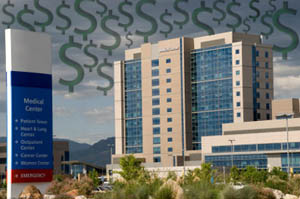A study of autoworker claims found that hospitals with the highest prices tended to have the strongest reputations and tight holds on their local markets yet showed little evidence of providing better quality care.
 The actual prices insurers pay hospitals are closely guarded secrets in health care. That has made it hard for health researchers to study one of the most important issues: whether patients get better treatments from more expensive hospitals. Hospital list prices, which Medicare published last year, provide no indication about how much hospitals actually are compensated by private insurers.
The actual prices insurers pay hospitals are closely guarded secrets in health care. That has made it hard for health researchers to study one of the most important issues: whether patients get better treatments from more expensive hospitals. Hospital list prices, which Medicare published last year, provide no indication about how much hospitals actually are compensated by private insurers.
In this study, published online Wednesday in the journal Health Affairs, researchers got a rare peek into hospitals’ real prices by analyzing nearly 25,000 insurance claims filed by current and retired auto workers in 10 metropolitan markets: Buffalo; New York; Cleveland; Detroit; Flint, Mich.; Indianapolis; Kansas City; St. Louis; Toledo, Ohio; Warren, Mich., and Youngstown, Ohio.
The workers went to 110 hospitals, which the researchers divided into three categories: 30 low-priced hospitals (with prices 10 percent or more below average); 30 high-priced hospitals (10 percent or more above average); and 50 medium-priced hospitals. The researchers adjusted their analysis to account for the different ailments that brought patients to the hospitals.
The study found high-priced hospitals were twice as large as the low-priced hospitals. Their market shares were three times as large as the low-priced hospitals, often through affiliations with large health systems. Market dominance is one of the major explanations for why some hospitals are able to extract higher prices from insurers during negotiations, since the insurers are reluctant to irk consumers by leaving these hospitals out of their networks.
The expensive hospitals were much more likely than other hospitals to win a national ranking for high quality from U.S. News & World Report, which relies strongly on doctor surveys in its analyses. In fact, the researchers found that none of the low-priced hospitals showed up on any U.S. News lists, while one out of four high-priced hospitals showed up on the list.
However, more qualitative, albeit rudimentary data, did not show expensive hospitals excelling. They performed worse than low-priced hospitals in keeping patients from being readmitted within a month and for avoiding blood clots and death in surgical patients. They also did no better in keeping heart attack and pneumonia patients alive than did low-price hospitals, although they were more successful in averting death for heart failure patients. Their overall ratings among patients were not significantly different than low-price hospitals.
The researchers — Chapin White, James D. Reschovsky and Amelia M. Bond — did not take a stand on whether the high prices were warranted, and they characterized the evidence as “mixed.” They noted it is possible that the expensive hospitals might offer much better specialized care, but the current quality measures do not assess those, instead focusing on the experiences of the routine patients.
Teaching hospitals made up nearly half of all the high-priced hospitals but only 17 percent of low-priced hospitals. The expensive hospitals tended to be in places where competitors were near rather than regions where they were the only facility around, even though in those isolated places insurers have no other options and therefore less negotiating leverage.
The researchers found partial justification for higher prices charged by these hospitals. They tended to treat sicker and poorer patients, often received referrals from other hospitals and were more likely to offer specialized, expensive services. And their operating margins were worse: the average loss was 2.8 percent, while low-priced hospitals had an average operating profit margin of 1.5 percent.
But when the researchers factored in all sources of revenue, including donations and investments, they found the total margins for high-priced hospitals were a healthy 4.5 percent, statistically no different than those of low-priced hospitals.






